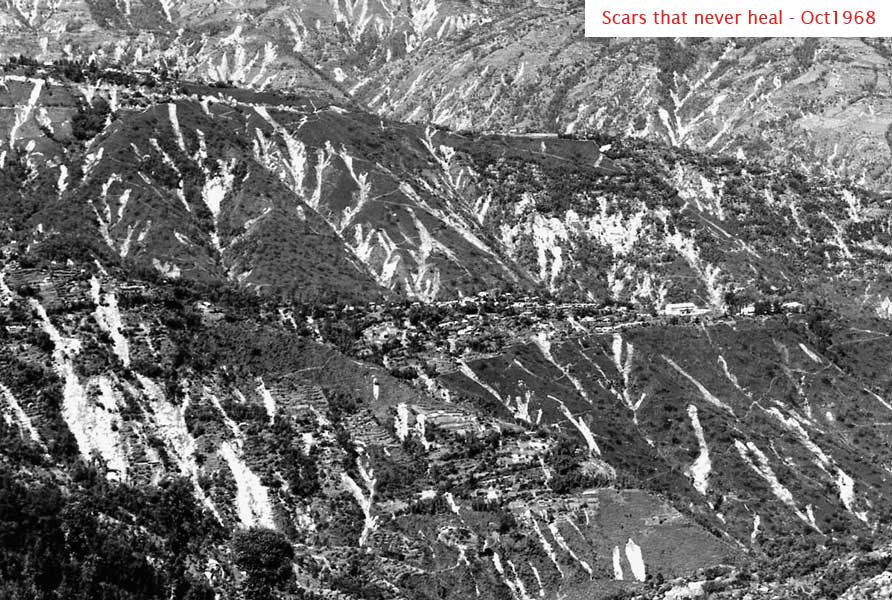30 September 2022
Landslides in the 1960s
Posted by Dave Petley

Landslides triggered by the October 1968 rainstorms in Darjeeling, India. Image from the Save the Hills blog, Image by Das Studio.
Landslides in the 1960s
As I was writing my blog post earlier this week about the 1961 Kurenivka mudslide in Ukraine, I was pondering the number of large landslide disasters that occurred in the 1960s. Based on no scientific analysis at all, it seems that this was a period of remarkable landslide accidents. So, I decided that it would be interesting to begin the process of putting together a list. This is what I have come up with so far:
- The M=9.4 22 May 1960 Valdivia Earthquake in Chile, the most powerful seismic event in instrumented history, which triggered huge numbers of landslides, including the valley blocking landslide at Riñihuazo.
- The 3 February 1961 Jupille landslide in Belgium, a fly ash failure that killed 11 people.
- The 13 March 1961 Kurenivka mudslide in Ukraine, which killed about 1,500 people
- The 10 January 1962 Huascarán landslide, in which 13 million cubic metres of rock and ice detached from Nevados Huascarán in Peru, killing an estimated 4,000 people. This was followed by a second, larger, event in 1970.
- The 9 October 1963 Vajont landslide, in which a 260 million cubic metre failure on the flanks of Mount Toc sent a huge wave over the crest of the Vajont dam, killing 1,917 people.
- The M=9.2 27 March 1964 Great Alaskan Earthquake, which triggered a large number of landslides. In the city of Valdez, 32 people were killed by a landslide that caused the collapse of the harbour and docks. In the Turnagan neighbourhood, 75 houses were destroyed by landslides.
- The 9 January 1965 Hope Landslide in Canada, which has an estimated volume of 47 million cubic metres. The remote location meant that only four people were killed.
- The 28 March 1965 El Cobre tailings dam failure in Chile, which killed over 200 people.
- The 2 January 1966 Rio de Janeiro landslides in Brazil, which killed at least 114 people. Some reports indicate that the final toll may have been about 250 people. The USGS suggests it may have been about 1,000 people.
- The 21 October 1966 Aberfan landslide in Wales, in which 144 people, the majority of whom were children, were killed by the failure of a coal waste tip.
- The 22-23 January 1967 Rio de Janeiro and Serra Das Araras landslides, which the USGS estimates killed 1,700 people.
- The 20 March 1967 landslides at Caraguatatuba in Brazil, which killed 120 people.
- The October 1968 Darjeeling landslides. It is estimated that heavy rainfall triggered over 20,000 landslides, killing thousands of people.
- The 17 August 1968 debris flow at Hida in Japan, win which two buses were lost, killing 104 people.
I am sure that there are many more disasters in the 1960s – please let me know what I have missed. Notable in the above list is the series of landslides that were caused by earthquakes, including the huge events in Chile and Alaska, and landslides caused by technological failures (including Kurenivka, Jupille, Vajont, El Cobre and Aberfan). These series of events through the decade were instrumental in the scientific work in the following decades that has led to our current understanding of landslides.


 Dave Petley is the Vice-Chancellor of the University of Hull in the United Kingdom. His blog provides commentary and analysis of landslide events occurring worldwide, including the landslides themselves, latest research, and conferences and meetings.
Dave Petley is the Vice-Chancellor of the University of Hull in the United Kingdom. His blog provides commentary and analysis of landslide events occurring worldwide, including the landslides themselves, latest research, and conferences and meetings.
Hi David,
This just came up in my Twitter ad feed.
https://research.unimelb.edu.au/research-at-melbourne/climate-hub/our-climate-capability/saving-lives-by-predicting-catastrophic-landslides?twclid=23g0nt2n9wtu8vvy5aapwqzqxq&utm_source=twitter&utm_medium=social&utm_campaign=R_All_2022_AC_SR_AI_AP_AW_feit_tgt&utm_content=stc_artcl_article2_lrnmr&sfid=7012e000000BRwCAAW
Mass activation of landslides in the spring of 1969 in the mountains of Central Asia. The spring of 1969 still remains a record for the number of newly formed and activated old landslides in the entire history of observations in the Central Asian region. On a vast territory, including mountain slopes, foothills and the valley part of the Fergana Valley, almost 2,000 landslides occurred in Kyrgyzstan and Uzbekistan alone, mainly in loess deposits that cover the slopes bordering the valley. The main reason for the massive catastrophic activation of landslides, which began at the beginning of the second decade of March 1969, was the combination of intense melting of the anomalously thick snow cover with the peak of spring rains. The amount of atmospheric precipitation from November 1968 to May 1969 exceeded the long-term average by more than 2 times. Along with this, the winter of 1968-69. characterized by record snow accumulation, which exceeded the norm by 1.5-3.0 times, the height of snow cover in the foothills of the Fergana Valley at the end of February exceeded 140 cm. The total water reserve in the snow cover reached an extremely high value – 612 cm. (with a delay of 10-20 days), rainy, with sharp fluctuations in air temperature. This combination of an abnormally cold and wet winter with an abnormally wet spring has caused a huge number of new landslides throughout Central Asia. In fact, in the entire history of hydrometeorological observations, starting from 1913, such a combination of anomalous precipitation and temperature, both in the cold and in the spring period of 1969, has not been repeated.
The width of the left stream at the head was 650 m, and the depth reached 40 m. The total volume of the landslide was about 5 million m3. The coordinates of the left side of the landslide: 41.145704°N; 72.916148°E.
Most interesting – as usual. The Hope slide is indeed unexplained and fascinating. We have no confidence for how to forecast such a major rock slide even now.
https://www.ashcroftcachecreekjournal.com/home/golden-country-what-caused-the-hope-slide/